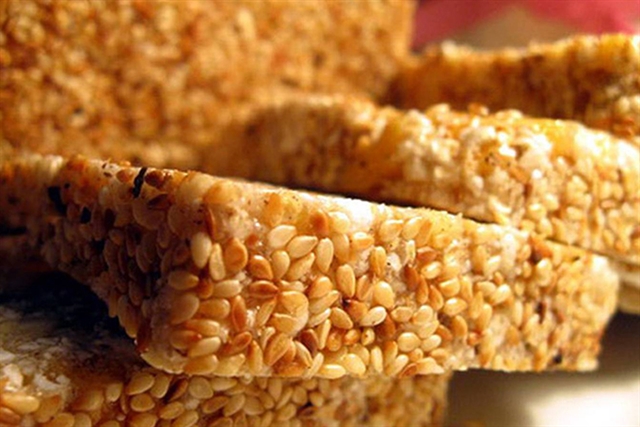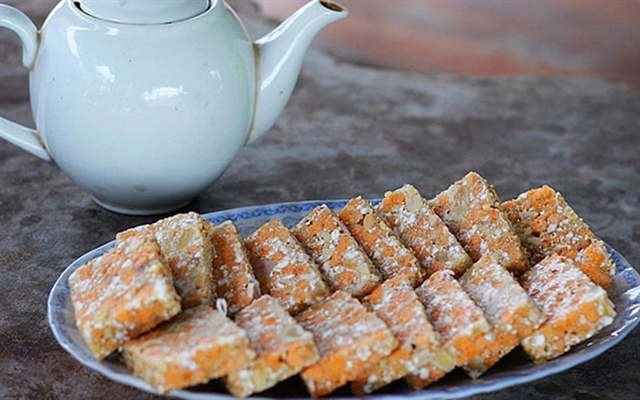 Life & Style
Life & Style

Thái Bình is commonly known for its immense rolling fields, but a tastier treat it is home to is the bánh cáy, or cáy cakes, made of sticky rice, sugar, gấc (gardenia fruit), sesame seeds, carrots, mandarin peel and lard.
By Hà Nguyễn and Hoàng Hồ
Thái Bình is commonly known for its immense rolling fields, but a tastier treat it is home to is the bánh cáy, or cáy cakes, made of sticky rice, sugar, gấc (gardenia fruit), sesame seeds, carrots, mandarin peel and lard.
The name cáy originates from the cakes' appearance because they resemble the eggs of the cáy, a small crab found in rivers and rice paddies. The cakes are traditionally served with tea, 68-year-old local woman Nguyễn Thị Út said.

|
| Bánh cáy (cáy) cake is must-try in Thái Bình. — Photo pasgo.vn |
Út told me a story about the cake's birthplace, Nguyễn Village. During the 1700s Nguyễn Thị Tần, the daughter of a Nguyễn Dynasty mandarin, was selected by King Lê Hiển Tông to nurse his son Lê Duy Vỹ, who was later crowned prince.
When the prince grew up, he was arrested by a Trịnh Lord for trying to consolidate the Lê Dynasty’s power. Only Tần was allowed to meet Vỹ, who said he could not eat the food he was given in prison.
Years later Tần retired to her village and handed down the job to her neighbours. When the prince was released and crowned King, he asked Tần’s villagers to offer him the cake every year.
And they are still making the cakes today, Út said.
To make a tasty and delicious cáy cake involves a very complicated process and many stages.
Other ingredients for the cake include gấc (a fruit found in Southeast Asia) or gardenia fruit, peanuts, ginger, carrots and mandarin peel, said Út.
The glutinous rice is divided into three parts, two for steaming with gấc to create the scarlet colour and gardenia for a bright yellow hue.
The glutinous rice is then ground in a stone mortar using a pestle until it becomes a dough. This is rolled out and cut into pieces (5cm by 1cm) and dried before frying it until crispy.

|
| Cáy is more enjoyable when eaten with a cup of tea. — Photo dulichvietnam.com.vn |
Út said all the ingredients are then mixed with sugar cane and cooked until fragrant before they're put in moulds coated with roasted sesame seeds and compressed until hard.
“The cakes should not be dried under the sun or by the fire. They can be kept for several months,” Út said, adding that the Thái Bình cakes sold well across the country and the world.
“IT's not just about making a profit. It's much more important for us to keep this traditional job going because it was handed down by our ancestors in an effort to serve customers inside and outside the country,” he said, noting that the village had registered a trademark for the cake to develop the job sustainably.
Tô Thanh Bình from Bắc Ninh Province said he was an addict. “I often order the cakes from Thái Bình to offer to our ancestors during the Tết holiday or for weddings,” Bình said, adding that several households in his province made the cake but it just wasn't the same as Thái Bình’s.
Trương Thị Dung from Australia told Việt Nam News that she sometimes craves the cakes and whenever she has a chance to return to the country she often travels to Thái Bình to buy them.
Herbalist Hoàng Văn Dần from the Thái Bình Traditional Medicinal Centre warned however that bánh cáy is although rich in protein and calories so people suffering from diabetes or obesity should avoid them.
“I still enjoy a cake with a cup of strong tea every day with my friends. It's my guilty pleasure,” Dần said. — VNS




